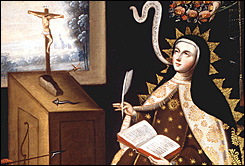Saint Teresa of Avila,18th century. Artist unknown, Cuzco school, Peru. Oil on canvas: 50" x 42" without frame. Purchased with funds provided by Dr. Jason Bacon, by exchange

Numbers of European-trained artists settled in the Americas and established guilds. The painters’ guild was founded in 1557; the carpenters’ guild (including woodcarvers, joiners, and musical instrument makers) was founded in 1568. Embroidery and pottery guilds were also organized. Guilds did not exclude Indian artists, but they formalized European control over accepted styles and techniques.